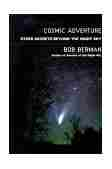 COSMIC ADVENTURE : OTHER SECRETS BEYONE THE NIGHT SKY
by Bob Berman
COSMIC ADVENTURE : OTHER SECRETS BEYONE THE NIGHT SKY
by Bob Berman
$12.92
From the most extraordinary cosmic phenomena to the basics of the
natural world, Berman challenges us to look at the facts, discoveries,
concepts, and awesome wonders of our cosmos in a new light. Written in
entertaining, jargon-free language that even a novice stargazer will
understand, Cosmic Adventure is a fun-filled, thought-provoking
exploration of the secrets beyond the night sky.
 SECRETS OF THE NIGHT SKY: THE MOST AMAZING THINGS IN THE UNIVERSE YOU CAN SEE WITH THE NAKED EYE
Bob Berman. Mr. Berman takes you on a tour of the night sky pointing
out its highlights and its history along with a wealth of practical tips
and tricks. This is a good book for beginners and those who want to
advance.
SECRETS OF THE NIGHT SKY: THE MOST AMAZING THINGS IN THE UNIVERSE YOU CAN SEE WITH THE NAKED EYE
Bob Berman. Mr. Berman takes you on a tour of the night sky pointing
out its highlights and its history along with a wealth of practical tips
and tricks. This is a good book for beginners and those who want to
advance.
![]()
 NATIONAL AUDUBON SOCIETY FIELD GUIDE TO THE NIGHT SKY (Audubon Society Field Guide Series)
by Mark R. Chartrand, Mark R. Chatrand, Jane Friedman (Editor) My boys
love this field guide. They call it the "good one". A handbook for
skygazers that combines the best in astrophotography with a unique
system of beautiful and easy-to-read star charts. Designed to make it
simple for the reader to find and identify every major natural celestial
object visible throughout the year with up-to-the-minute research and
clear, accessible text, charts, and cross-references.
NATIONAL AUDUBON SOCIETY FIELD GUIDE TO THE NIGHT SKY (Audubon Society Field Guide Series)
by Mark R. Chartrand, Mark R. Chatrand, Jane Friedman (Editor) My boys
love this field guide. They call it the "good one". A handbook for
skygazers that combines the best in astrophotography with a unique
system of beautiful and easy-to-read star charts. Designed to make it
simple for the reader to find and identify every major natural celestial
object visible throughout the year with up-to-the-minute research and
clear, accessible text, charts, and cross-references.
![]() SKYGUIDE A Field Guide to the Heavens by Mark R. Chartrand III. Golden Press, New York
SKYGUIDE A Field Guide to the Heavens by Mark R. Chartrand III. Golden Press, New York
You will eventually need a field guide. I suggest that you check
out those in the library before you buy any. See which one you like
using the most. I got this at my husband's used book store. It has
been very helpful. This is the book I would read before I went out to
do my star gazing. This is the book I used to study about the
constellations and stars. Everyone in my astronomy class has a field
guide and we all use them to this day.
 TURN LEFT AT ORION: A HUNDRED NIGHT SKY OBJECTS TO SEE IN A SMALL TELESCOPE-AND HOW TO FIND THEM
by Dan M. Davis, Guy J. Consolmagno, Daniel M. Davis
TURN LEFT AT ORION: A HUNDRED NIGHT SKY OBJECTS TO SEE IN A SMALL TELESCOPE-AND HOW TO FIND THEM
by Dan M. Davis, Guy J. Consolmagno, Daniel M. Davis
$17.47 Hardcover - 205 pages 2Nd/Rev edition
This delightfully illustrated and easy to understand guidebook is
for the beginning astronomer includes maps and large-format drawings of
over 100 deep-sky objects you can see with a small telescope. In this
revised edition, the authors have brought information on the planets and
eclipses up-to-date and have extended the observing tables to the year
2006.
 THE BACKYARD ASTRONOMER'S GUIDE
by Terence Dickinson, Alan Dyer (Contributor), Barry Estabrook (Editor)
THE BACKYARD ASTRONOMER'S GUIDE
by Terence Dickinson, Alan Dyer (Contributor), Barry Estabrook (Editor)
$27.97 Hardcover - 298 pages (October 1991)
An essential reference tool for both beginning and veteran sky
observers. Drawing on decades of stargazing experience, the authors
suggest what equipment to buy and what to avoid, describe observing
techniques, and explain how to hunt down the most interesting celestial
objects. Each chapter is illustrated with the latest, breathtaking
astrophotography.
 NIGHTWATCH: A PRACTICAL GUIDE TO VIEWING THE UNIVERSE
by Terence Dickinson, Timothy Ferris, Victor Costanzo (Illustrator)
NIGHTWATCH: A PRACTICAL GUIDE TO VIEWING THE UNIVERSE
by Terence Dickinson, Timothy Ferris, Victor Costanzo (Illustrator)
$23.96 Paperback - 172 pages Spiral edition (November 1998)
With 250,000 copies in print since its initial publication in 1983,
"Nightwatch" has become a standard reference guide for stargazers
throughout North America.
The new Third Edition expands on that success with a completely revised
and updated text, more than 100 new color photos and diagrams and 16
additional pages that cover such! new astronomical pursuits as
computerized telescopes, reviews of new telescope designs and
accessories, and astronomy on the Internet.
All charts, tables and diagrams have been updated and, in some cases,
redesigned for easier use. Improved spacecraft measurements of the
distances to the stars (recently released by the European Space Agency)
are included in the charts, along with additional observing tips for
stargazers using binoculars and telescopes. An expanded chapter on
Astrophotography lists the best modern films and cameras for
skyshooting. The new "Nightwatch" is faithful to the "ultra-simplified,
no jargon" philosophy of the original, and at the same time, offers
substantially more practical information for the novice and
intermediate-level amateur astronomer. The Royal Astronomical Society of
Canada called the first edition "the best of its kind"- the new Third
Edition is better still. It is still an abundantly illustrated, wi!
de-sized, spiral-bound volume designed to lay flat for easy! reference
during many starlit nights.
 OBSERVING COMETS, ASTROIDS, METEORS, AND THE ZODIACAL LIGHT (Practical Astronomy Handbooks 5)
by Stephen J. Edberg, David H. Levy (Contributor)
OBSERVING COMETS, ASTROIDS, METEORS, AND THE ZODIACAL LIGHT (Practical Astronomy Handbooks 5)
by Stephen J. Edberg, David H. Levy (Contributor)
$20.95 Hardcover - 243 pages (January 1995)
When can you see fireballs and who should you contact if you spot
one? When is it best to hunt for comets and meteors and whereabouts? How
do you gauge the size of the coma in the head of a comet and estimate
its degree of condensation? Clear and easy to use, this guide shows you
how to make successful and valuable observations and records of comets,
asteroids, meteors and the zodiacal light. For each topic the historical
background and current scientific understanding support a wealth of
observational techniques. Comet observers are shown techniques for
search and discovery. They can learn how to make visual estimates of
brightness and size, and how to make photographic studies of cometary
heads and tails. Asteroid hunters will find a 'life list' of quarry and
guidelines on how to search for these objects and then how to photograph
or electronically image them. Fruitful photographic and electronic
methods for studying meteors and meteor showers are provided. Visual and
photographic techniques show you how to examine the often elusive
zodiacal light. The more adventurous are provided with advanced
techniques on how to make successful astrometric, spectroscopic and
electronic observations. This is rounded off with an invaluable list of
centres world-wide to contact with your details of unusual sightings.
 STAR WARE : THE AMATURE ASTRONOMER'S ULTIMATE GUIDE TO CHOOSING, BUYING, AND USING TELESCOPES AND ACCESSORIES
STAR WARE : THE AMATURE ASTRONOMER'S ULTIMATE GUIDE TO CHOOSING, BUYING, AND USING TELESCOPES AND ACCESSORIES
by Philip S. Harrinfton, Philip S. Harrington
19.95 Paperback - 384 pages 2nd edition (August 1998)
A user-friendly guide offering all the necessary information for
anyone purchasing a telescope, using one for the first time or upgrading
current equipment. Includes a comparison of available telescopes
describing which are best suited to specific needs. Contains scores of
handy tips, diagrams, illustrations and activities and suggests what to
look for in the night sky.
 ADVANCED SKYWATCHING
The Backyard Astronomer's Guide to Starhopping and Exploring the
Universe by Robert Burnham, Alan Dyer, Robert A Garfinkle, Martin
George, Jeff Kanipe, David H. Levy. The Nature Company, Time Life Books
ADVANCED SKYWATCHING
The Backyard Astronomer's Guide to Starhopping and Exploring the
Universe by Robert Burnham, Alan Dyer, Robert A Garfinkle, Martin
George, Jeff Kanipe, David H. Levy. The Nature Company, Time Life Books
This is a good book to read once you have found many of the
constellations. It also offers some excellent advice about how to
choose the best binoculars when you decide to buy a pair for astronomy.
My astronomy class use the advice from this book to choose those we
bought. It has sky maps and beautiful pictures.
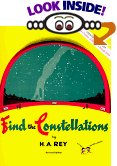 FIND THE CONSTELLATIONS
. by H. A. Rey
A 'must' for public and school libraries and a wonderful book for an
individual or family to own. A delightfully illustrated, informative
beginner's guide to locating and identifying constellations in the
northern hemisphere, with an extensive index, glossary, and time table
for sky viewing.
FIND THE CONSTELLATIONS
. by H. A. Rey
A 'must' for public and school libraries and a wonderful book for an
individual or family to own. A delightfully illustrated, informative
beginner's guide to locating and identifying constellations in the
northern hemisphere, with an extensive index, glossary, and time table
for sky viewing.
 THE STARS: A NEW WAY TO SEE THEM
. by H. A. Rey
The Stars is the best book available for its purpose. It is also a
brilliant example of the combined use of art and writing in bringing
science to the layman. This is a clear, vivid text with charts and maps
showing the positions of the constellations the year round. I have
read about this book in many other books. This is THE book for a
beginner. This is one of the best books for older childern.
THE STARS: A NEW WAY TO SEE THEM
. by H. A. Rey
The Stars is the best book available for its purpose. It is also a
brilliant example of the combined use of art and writing in bringing
science to the layman. This is a clear, vivid text with charts and maps
showing the positions of the constellations the year round. I have
read about this book in many other books. This is THE book for a
beginner. This is one of the best books for older childern.
 APOLLO: THE EPIC JOURNEY TO THE MOON
. by David West Reynolds, Wally Schirra, Von Hardesty
This title is definitely one of the best books written about Apollo in
recent years. An exuberantly visual treatment of the Saturn/Apollo
combination and its specific missions, the work also rues the fact that
the Apollo program was rushed to meet JFK's deadline, and didn't fully
realize the dreams of Werner von Braun and other 1950s space dreamers
whose visions were captured in the paintings of Chesley Bonestell. These
form several of a train of full-page sidebars that dominate this book, a
design element that invites browsing. Almost every major component of
the Apollo complex is displayed, from the ground installations, to the
titanic first stage, up to the moonwalker's spacesuit. Standing out
among these layouts are those devoted to the most daring and
scientifically significant missions, Apollo 15 and 17. Using a panoramic
photographic mosaic of those two landing sites amid mountains, Reynolds
forcefully impresses the otherworldliness of the moon. In the windup,
Reynolds shows von Braun's plan and illustrations for scaling up Apollo
into a space station, moon bases, and expeditions to Mars. Instead,
following the Skylab interlude, Apollo was turned over to scrap dealers
and museum curators. Reynolds' work will attract throngs of readers.
Gilbert Taylor
Copyright © American Library Association. All rights reserved
APOLLO: THE EPIC JOURNEY TO THE MOON
. by David West Reynolds, Wally Schirra, Von Hardesty
This title is definitely one of the best books written about Apollo in
recent years. An exuberantly visual treatment of the Saturn/Apollo
combination and its specific missions, the work also rues the fact that
the Apollo program was rushed to meet JFK's deadline, and didn't fully
realize the dreams of Werner von Braun and other 1950s space dreamers
whose visions were captured in the paintings of Chesley Bonestell. These
form several of a train of full-page sidebars that dominate this book, a
design element that invites browsing. Almost every major component of
the Apollo complex is displayed, from the ground installations, to the
titanic first stage, up to the moonwalker's spacesuit. Standing out
among these layouts are those devoted to the most daring and
scientifically significant missions, Apollo 15 and 17. Using a panoramic
photographic mosaic of those two landing sites amid mountains, Reynolds
forcefully impresses the otherworldliness of the moon. In the windup,
Reynolds shows von Braun's plan and illustrations for scaling up Apollo
into a space station, moon bases, and expeditions to Mars. Instead,
following the Skylab interlude, Apollo was turned over to scrap dealers
and museum curators. Reynolds' work will attract throngs of readers.
Gilbert Taylor
Copyright © American Library Association. All rights reserved
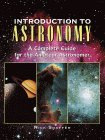 INTRODUCTION TO ASTRONOMY
. by Rick Shaffer
Since one of my very favorite books on astronomy for beginners was
written by Mr. Shaffer, I just had to have this one too. Mr. Shaffer
writes with skill and humor. He knows just how to explain the most
difficult of concepts in a way that anyone can understand. This book is
filled with great information.
INTRODUCTION TO ASTRONOMY
. by Rick Shaffer
Since one of my very favorite books on astronomy for beginners was
written by Mr. Shaffer, I just had to have this one too. Mr. Shaffer
writes with skill and humor. He knows just how to explain the most
difficult of concepts in a way that anyone can understand. This book is
filled with great information.
 SKYWATCHING
by David H. Levy and John O'Byrne This is a good book for beginners.
It is filled with useful information. It is also beautifully
illustrated. It includes sky charts and constellations maps and an
annotated resource directory.
SKYWATCHING
by David H. Levy and John O'Byrne This is a good book for beginners.
It is filled with useful information. It is also beautifully
illustrated. It includes sky charts and constellations maps and an
annotated resource directory.
![]() THE HEAVENS ON FIRE : THE GREAT LEONID METEOR STORMS
by Mark Littmann
THE HEAVENS ON FIRE : THE GREAT LEONID METEOR STORMS
by Mark Littmann
$27.97 Hardcover - 288 pages (December 1998)
The Heavens on Fire tells the story of meteors, especially the
spectacular Leonid showers. Publication coincides with the peak activity
in mid-November 1998 and 1999, when swarms of a thousand meteors an
hour may be seen. The great scientists who founded meteor science, the
tumultuous history of meteors, and the dangers posed to Earth by
asteroids and comets are all lucidly introduced. This is a highly
readable account of the terrifying beauty of meteors and their
spectacular showers.
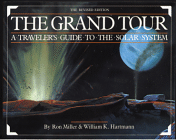 THE GRAND TOUR A TRAVELER'S GUIDE TO THE SOLAR SYSTEM by Ron Miller and William K. Hartmann. Workman Publishing , New York.
THE GRAND TOUR A TRAVELER'S GUIDE TO THE SOLAR SYSTEM by Ron Miller and William K. Hartmann. Workman Publishing , New York.
This is one of my newest books. I have really enjoyed it. It not
only has wonderful pictures, but it is also packed with information. It
is a fun book.
![]()
 EXPLORING THE NIGHT SKY WITH BINOCULARS
by Patrick Moore This is not for beginners. You need to be very
familiar with the constellations before you start searching for the deep
sky objects that can be seen with binoculars. Once you are, you will
enjoy the things a good pair of binoculars will reveal to you. On a
starry night, the beauty and immensity of our universe is awe-inspiring.
After describing how to select and use binoculars for observation, this
handbook explains basic astronomy and charts, season by season, the sky
as seen from northern and southern hemispheres.
EXPLORING THE NIGHT SKY WITH BINOCULARS
by Patrick Moore This is not for beginners. You need to be very
familiar with the constellations before you start searching for the deep
sky objects that can be seen with binoculars. Once you are, you will
enjoy the things a good pair of binoculars will reveal to you. On a
starry night, the beauty and immensity of our universe is awe-inspiring.
After describing how to select and use binoculars for observation, this
handbook explains basic astronomy and charts, season by season, the sky
as seen from northern and southern hemispheres.
![]() DEEP-SKY COMPANIONS: THE MESSIER OBJECTS
by Stephen James O'Meara, David H. Levy
$34.95
Hardcover - 336 pages
This completely new work will inspire amateur astronomers to visit the
110 most famous galaxies, clusters and nebulae in the sky. It is the
ultimate field guide to the Messier objects, first catalogued in the
late 1700s.Using the finest optical telescopes available for amateur
work, superior eyepieces and the darkest site on Earth, the author
describes and sketches the view from the telescope as never before. With
new data and clear finder charts, this is truly the Messier Guide for
the modern age.
DEEP-SKY COMPANIONS: THE MESSIER OBJECTS
by Stephen James O'Meara, David H. Levy
$34.95
Hardcover - 336 pages
This completely new work will inspire amateur astronomers to visit the
110 most famous galaxies, clusters and nebulae in the sky. It is the
ultimate field guide to the Messier objects, first catalogued in the
late 1700s.Using the finest optical telescopes available for amateur
work, superior eyepieces and the darkest site on Earth, the author
describes and sketches the view from the telescope as never before. With
new data and clear finder charts, this is truly the Messier Guide for
the modern age.
 A FIELD GUIDE TO THE STARS AND PLANETS (Peterson Field Guides)
by Jay M. Pasachoff, Donald H. Menzel, Roger Tory Peterson. Because I
like the Peterson Field Guides, I included this one.
Substantially expanded (new color photos) and revised since the last
edition published a decade ago, this field guide serves as a sky tour
for amateurs and a reference to data (through 1997) for more experienced
observers. Includes 72 star maps and 52 atlas charts.
A FIELD GUIDE TO THE STARS AND PLANETS (Peterson Field Guides)
by Jay M. Pasachoff, Donald H. Menzel, Roger Tory Peterson. Because I
like the Peterson Field Guides, I included this one.
Substantially expanded (new color photos) and revised since the last
edition published a decade ago, this field guide serves as a sky tour
for amateurs and a reference to data (through 1997) for more experienced
observers. Includes 72 star maps and 52 atlas charts.
![]() THE BINOCULAR STARGAZER : A BEGINNERS GUIDE TO EXPLORING THE SKY
by Leslie C. Peltier
$15.96
This is an excellent introduction into binocular astronomy. It takes you
from the beginnings of finding the first few basic constellations to
mastering the low magnification skydome. There is also much on the many
different types of binocular astronomy, such as variable star
observations.
THE BINOCULAR STARGAZER : A BEGINNERS GUIDE TO EXPLORING THE SKY
by Leslie C. Peltier
$15.96
This is an excellent introduction into binocular astronomy. It takes you
from the beginnings of finding the first few basic constellations to
mastering the low magnification skydome. There is also much on the many
different types of binocular astronomy, such as variable star
observations.
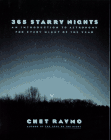 365 STARRY NIGHTS: AN INTRODUCTION TO ASTRONOMY FOR EVERY NIGHT OF THE YEAR
by Chet Raymo
This book is a great way for a beginner to learn the night sky. It
doesn't require any previous knowledge of the heavens. No need to start
at the beginning just turn to the month in question and start reading.
What's visible on a particular date in the sky is presented in black and
white drawing with text giving a brief description about it. The more I
use this book, the more I like it. Anyone beginning a hobby in
astronomy or anyone teaching an astronomy unit needs this book. Put it
on your must have list.
365 STARRY NIGHTS: AN INTRODUCTION TO ASTRONOMY FOR EVERY NIGHT OF THE YEAR
by Chet Raymo
This book is a great way for a beginner to learn the night sky. It
doesn't require any previous knowledge of the heavens. No need to start
at the beginning just turn to the month in question and start reading.
What's visible on a particular date in the sky is presented in black and
white drawing with text giving a brief description about it. The more I
use this book, the more I like it. Anyone beginning a hobby in
astronomy or anyone teaching an astronomy unit needs this book. Put it
on your must have list.
 THE PRACTICAL ASTRONOMER by Colin A Ronan. Bonanza Books
THE PRACTICAL ASTRONOMER by Colin A Ronan. Bonanza Books
This was one of the first books I read. I found it very helpful.
It was full of good information for beginners. It was one of the
resources I used when I taught a basic astronomy class.
![]() ATLAS OF THE MOON
by Antonin Rukl, Thomas W. Rackham
$24.47
This is a great book for telescope users and a fine one for ordinary
browsers. It is an up-to-date atlas of the observable part of the moon.
Maps of the moon compose the bulk of the book's 224 pages.
The introduction discusses history, terminology, phases of the moon, and
the moon's surface. This is followed by maps of 76 sections of the near
side of the moon, each accompanied by a small locator map. Facing pages
include place-names and their derivations as well as map coordinates.
Following the maps are photographs of interesting lunar formations
(craters, ring mountains, walled plains), advice on setting up and using
a telescope, descriptions of eclipses, and a glossary. There is a
thorough bibliography and index of named formations at the end of the
book. One can look up Amundsen, for example, and locate the ring
mountain named after him.
ATLAS OF THE MOON
by Antonin Rukl, Thomas W. Rackham
$24.47
This is a great book for telescope users and a fine one for ordinary
browsers. It is an up-to-date atlas of the observable part of the moon.
Maps of the moon compose the bulk of the book's 224 pages.
The introduction discusses history, terminology, phases of the moon, and
the moon's surface. This is followed by maps of 76 sections of the near
side of the moon, each accompanied by a small locator map. Facing pages
include place-names and their derivations as well as map coordinates.
Following the maps are photographs of interesting lunar formations
(craters, ring mountains, walled plains), advice on setting up and using
a telescope, descriptions of eclipses, and a glossary. There is a
thorough bibliography and index of named formations at the end of the
book. One can look up Amundsen, for example, and locate the ring
mountain named after him.
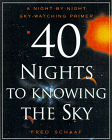 40 NIGHTS TO KNOWING THE SKY: A NIGHT BY NIGHT SKYWATCHING PRIMER
Fred Schauf. This book offers a simple, interactive, step-by-step
program to learning the night sky. It has a system of practical
objectives and activities that get readers actively involved in sky
watching
40 NIGHTS TO KNOWING THE SKY: A NIGHT BY NIGHT SKYWATCHING PRIMER
Fred Schauf. This book offers a simple, interactive, step-by-step
program to learning the night sky. It has a system of practical
objectives and activities that get readers actively involved in sky
watching
![]() YOUR GUIDE TO THE SKY by Rick Shaffer. Lowell House.
YOUR GUIDE TO THE SKY by Rick Shaffer. Lowell House.
This is a good book for beginners. It is easy to read and
understand, and it is packed with information. It also has a section
that highlights each month of the year telling the reader what
constellations and deep sky objects can be seen that month. I would
often read this information before I went out to see what I could see.
![]() SKY ATLAS 2000.0 : DELUXE
by Wil Tirion, Roger W. Sinnott Paperback - 30 pages 2nd spiral
edition $49.95 The long-awaited second edition of Wil Tirion's superb
Sky Atlas 2000.0 offers 30,000 additional stars and all the positions
are derived from the most accurate satellite data. The Atlas opens out
to reveal 26 charts, each one 20 inches wide and 15 inches deep. This
large format allows the stars, nebulas and galaxies to be displayed with
unrivalled clarity. Tirion's Sky Atlas is not only practical; its
exquisite maps of the night sky combine are beautiful examples of the
cartographer's skills.Copublished with Sky Publishing Corporation
SKY ATLAS 2000.0 : DELUXE
by Wil Tirion, Roger W. Sinnott Paperback - 30 pages 2nd spiral
edition $49.95 The long-awaited second edition of Wil Tirion's superb
Sky Atlas 2000.0 offers 30,000 additional stars and all the positions
are derived from the most accurate satellite data. The Atlas opens out
to reveal 26 charts, each one 20 inches wide and 15 inches deep. This
large format allows the stars, nebulas and galaxies to be displayed with
unrivalled clarity. Tirion's Sky Atlas is not only practical; its
exquisite maps of the night sky combine are beautiful examples of the
cartographer's skills.Copublished with Sky Publishing Corporation
![]() SKY & TELESCOPE
SKY & TELESCOPE
This magazine has some articles that are for beginners and some for
those who are not. They always contain useful information. They also
always have a calendar which shows what can be seen that month. My
astronomy class looks forward to the magazine and the calendar every
month.
 THE CAMBRIDGE STAR ATLAS
by Wil Tirion Hardcover - 90 pages 2nd edition (September 1996)
$13.97
After having established itself as a standard star atlas, ^IThe
Cambridge Star Atlas^R by internationally famous astronomical
cartographer, Wil Tirion, has now been improved. The popularity of this
book, first published in 1991, is that it covers the entire sky, both
northern and southern latitudes, in an attractive format suitable for
beginning as well as experienced astronomical observers. The basis of
the book is a series of twelve monthly sky charts, followed by an atlas
of the whole sky, arranged in twenty overlapping charts. Each chart
shows stars down to magnitude 6.5, together with about 900 nonstellar
objects, such as clusters and galaxies, that can be seen with binoculars
or a small telescope. There is also a comprehensive double-page map of
the Moon's surface, showing craters and other named features. For this
edition, author Tirion has added more detail to the monthly charts, and
has included "all-sky" charts of interesting patches of sky in the
northern and southern hemispheres. This book is the ideal reference
atlas for sky watchers everywhere.
THE CAMBRIDGE STAR ATLAS
by Wil Tirion Hardcover - 90 pages 2nd edition (September 1996)
$13.97
After having established itself as a standard star atlas, ^IThe
Cambridge Star Atlas^R by internationally famous astronomical
cartographer, Wil Tirion, has now been improved. The popularity of this
book, first published in 1991, is that it covers the entire sky, both
northern and southern latitudes, in an attractive format suitable for
beginning as well as experienced astronomical observers. The basis of
the book is a series of twelve monthly sky charts, followed by an atlas
of the whole sky, arranged in twenty overlapping charts. Each chart
shows stars down to magnitude 6.5, together with about 900 nonstellar
objects, such as clusters and galaxies, that can be seen with binoculars
or a small telescope. There is also a comprehensive double-page map of
the Moon's surface, showing craters and other named features. For this
edition, author Tirion has added more detail to the monthly charts, and
has included "all-sky" charts of interesting patches of sky in the
northern and southern hemispheres. This book is the ideal reference
atlas for sky watchers everywhere.
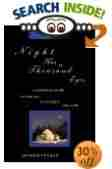 NIGHT HAS A THOUSAND EYES: A NAKED=EYE GUIDE TO THE SKY, ITS SCIENCE AND LORE
by Arthur Upgren
NIGHT HAS A THOUSAND EYES: A NAKED=EYE GUIDE TO THE SKY, ITS SCIENCE AND LORE
by Arthur Upgren
$11.20
Night Has a Thousand Eyes is the perfect resource for amateur
astronomers and meteorologists of all ages who pause to enjoy sunsets
and identify constellations on a starry night.
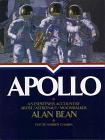 Apollo : An Eyewitness Account By Astronaut/Explorer Artist/Moonwalker
by Alan Bean, John Glenn (Introduction), Andrew L. Chaikin (Contributor)
Apollo : An Eyewitness Account By Astronaut/Explorer Artist/Moonwalker
by Alan Bean, John Glenn (Introduction), Andrew L. Chaikin (Contributor)
$31.50 Hardcover - 176 pages (October 1998)
When NASA sent the crew of Apollo 12 to the moon, they may not have
realized that they were giving an artist the vision that would carry him
through a lifetime of painting. The artist, of course, was astronaut
Alan Bean, whose trip to the moon with pals Pete Conrad and Dick Gordon
sunk so deeply into his brain that he's been trying to get it down on
canvas ever since. He even mixes moon dust and bits of charred Apollo 12
heat shield into his paints to capture a bit of the Ocean of Storms in
each image. The astronauts Bean paints are brave, exuberant, and
all-American, right down to the reflections of Old Glory in their
mirrored visors. His moon is surprisingly colorful and dreamlike, a
magical place for jumping higher than you ever did before, racing around
in the lunar rover, and swatting golf balls into orbit. Apollo: An
Eyewitness Account, coauthored with space expert Andrew Chaikin, is
filled with Bean's riveting stories and paintings, recording a long,
successful career as an explorer-artist. He recreates the drama and
brash enthusiasm of the Apollo program in bold strokes. --Therese
Littleton
 A Man on the Moon : The Voyages of the Apollo Astronauts
by Andrew L. Chaikin, Tom Hanks
A Man on the Moon : The Voyages of the Apollo Astronauts
by Andrew L. Chaikin, Tom Hanks
12.76 Paperback - 704 pages (April 1998)
A decade in the making, this book is based on hundreds of hours of
in-depth interviews with each of the twenty-four moon voyagers, as well
as those who contributed their brain power, training and teamwork on
Earth. In his preface Chaikin writes, "We touched the face of another
world and became a people without limits."
What follows are thrilling accounts of such remarkable experiences as
the rush of a liftoff, the heart-stopping touchdown on the moon, the
final hurdle of re-entry, competition for a seat on a moon flight, the
tragic spacecraft fire, and the search for clues to the origin of the
solar system on the slopes of lunar mountains.
 Countdown : A History of Space Flight
by T. A. Heppenheimer
Countdown : A History of Space Flight
by T. A. Heppenheimer
$21.00
Hardcover - 400 pages (May 1997)
Seasoned aerospace historian Heppenheimer incorporates all the latest
material from the former Soviet Union to produce a comprehensive
depiction of spaceflight, manned and unmanned. Although he covers much
familiar ground, the new data he has acquired allow him to dramatize the
extent to which limited resources handicapped Soviet military and
civilian space efforts, the early American lead in reconnaissance
satellites and large-thrust engines, and the emergence of cooperation in
recent manned spaceflights. Heppenheimer's general antipathy to manned
spaceflight will, however, be controversial, especially since he
dismisses it as vainglorious, refers to Soviet female cosmonauts as
"quota queens," and does not note the recent efforts at and the current
possibilities for making it substantially less expensive. Yet even
manned-spaceflight advocates who will excoriate the book for its biases
definitely should read it. Those who approach it more disinterestedly
will find it an invaluable reference for the technology and the politics
of spaceflight. Roland Green
 Deke! : U.S. Manned Space : From Mercury to the Shuttle
by Donald K. Slayton, Michael Cassutt (Contributor), Deke Slayton
Deke! : U.S. Manned Space : From Mercury to the Shuttle
by Donald K. Slayton, Michael Cassutt (Contributor), Deke Slayton
$11.96
Paperback Reprint edition (July 1995)
The autobiography of one of the original Mercury Seven astronauts,
this is one of the best additions to the literature of the early
American space effort. Slayton, who'd first flown as a World War II
bomber pilot, came to the space program by a somewhat circuitous route.
He was grounded in 1962 because of a heart murmur, and actually flew as
an astronaut only once, in the 1975 Apollo-Soyuz mission. He was head of
the astronaut office, however, and as such, one of the key persons
involved in selecting crew, a process he describes with an insider's
knowledge of detail and considerable frankness about the virtues and
limitations of his colleagues. At the same time, Slayton never lost, nor
will his readers miss, the sense of wonder with which space was
contemplated in the days when it was a high and gallant dream. Roland
Green
Copyright© 1994, American Library Association. All rights reserved
--This text refers to an out of print or unavailable edition of this
title.
I loved this book. I will caution you about the language in this book. There is cursing.
![]()
The following books are offered by
 The Creation Research Society. To order any of these books, go The Creation Research Society web site or by writing them at the following address.
The Creation Research Society. To order any of these books, go The Creation Research Society web site or by writing them at the following address.
 Astronomy and the Bible: Questions and Answers.
Astronomy and the Bible: Questions and Answers.
Donald B. DeYoung. 1988. Baker Book House, 146 pages. $8.00.
What is a black hole? Is there life in space? Which is the best
telescope to buy? This book is a concise summary of creationist
astronomy in a question/answer format. "How refreshing and rare to find
an astronomy book where God's Word, not scientific theory, finds
preeminence" (Christian Retailing). This book can be given to students
without any fear of corrupting their faith in Scripture. It makes a
welcome companion to more technical creationist presentations such as
Design and Origins in Astronomy. Its six chapters provide an unusually
large amount of information in a very readable style. The book contains a
glossary in addition to Scripture and subject indices. I used this
book in my astronomy class. I highly recommend it.
 Astronomy and Creation - An Introduction.
Astronomy and Creation - An Introduction.
Donald B. DeYoung. 1995. Creation Research Society Books, 59 pages. $5.45.
This volume is the first in a series of concise studies giving an
overview of a particular topic, in this case astronomy. The heavens (as
well as the earth itself) declare the clear message of creation. The
vast distances and numberless stars of deep space are simply beyond our
comprehension. Among all the sciences, surely astronomy is the best
teacher of humility. What then do the heavens teach us from a creation
perspective? This book considers five particular areas: origins, order,
structure, time scale, and change. The reader will find this treatment
of "outer space" to be a refreshing alternative to much of today's
scientific thinking. This book is the first in a series of short,
introductory texts published by the Creation Research Society. The
second, Physical Science and Creation; An Introduction, was also written
by Dr. DeYoung. I want this book next.
 Design and Origins in Astronomy.
Design and Origins in Astronomy.
Edited by George Mulfinger, Jr. 1983. CRS Monograph Series No. 2. Creation Research Society Books, 151 pages. $9.00.
This book presents a teleological study of the universe - a
creationist challenge to modern materialistic thought. Written in the
1970's, many of the arguments remain valid in the 1990's and are of
historical as well as scientific interest. Authors include George
Mulfinger, Donald DeYoung, John Whitcomb, Emmett Williams, Paul Steidl,
and Paul Wilt. A wide range of topics is presented - initial state of
the universe, a thermodynamics approach, the red shift controversy,
nucleosynthesis, and creationist views concerning the origin of the
solar system and the universe - as well as a Scriptural framework for
astronomy.
 Starlight and Time: Solving the Puzzle of Distant Starlight in a Young Universe.
D. Russell Humphreys. 1994. Master Books, 133 pages. $6.00.
Using concepts from the general theory of relativity, Dr. Humphreys has
derived a young earth cosmology which offers an explanation for the
existence of "old" starlight in a young universe. The author compares
his hypothesis to previous creationist explanations for the existence of
starlight that should have required millions of years to reach the
earth. Defects in the "big bang" theory are noted as well.
Starlight and Time: Solving the Puzzle of Distant Starlight in a Young Universe.
D. Russell Humphreys. 1994. Master Books, 133 pages. $6.00.
Using concepts from the general theory of relativity, Dr. Humphreys has
derived a young earth cosmology which offers an explanation for the
existence of "old" starlight in a young universe. The author compares
his hypothesis to previous creationist explanations for the existence of
starlight that should have required millions of years to reach the
earth. Defects in the "big bang" theory are noted as well.

 View Guestbook
View Guestbook
 © WebRing Inc. |
| |||||